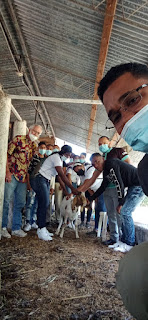Farmer-to-Farmer Supports Centro de Educación y Pomoción Rural (CEPROR) in Dominican Republic on October 2021.
Mr. Dan Miller, a volunteer of the Farmer to Farmer program and an expert on small ruminants, supported Centro de Educación y Pomoción Rural (CEPROR) in Dominican Republic on October 2021.
The purpose of the
assignment was to assess the current state of the community’s goat production
and conduct training in the best practices for goat husbandry and management. The
CEPROR is located in Santa Ana, Villa Tapia, Hermanas Mirabal province,
Dominican Republic.
Climatic conditions in the
area do not vary tremendously during the year with temperatures above 20ºC and
under 35ºC all year and precipitation of varying amounts during the year with
no month being completely dry. Changes in day length are also minimal so there
is no effect of day length on breeding season. Thus, there are no significant
seasonal changes to deal with as in other tropical countries. Climate change is
affecting previously reliable weather patterns.
The CEPROR has 40 members
who work with goat, rabbit and duck farmers and serves as a source of technical
training for small producers. Although it started as a small women’s
cooperative, it has since become a community association. The organization has
a polytechnic school with an agriculture program. Its curriculum consists of
two tracks - agriculture and commerce. It has a total of 240 students - 152
males and 88 females in grades 7 - 12. Most of the students come from the
surrounding area. They tend to be from a lower economic bracket. Mr. Miller
gave lectures and demonstrations on various topics of concern to juniors and
seniors in the program. He also had the opportunity to visit, with the students,
various farms on a field trip and to talk with some of the producers during the
lectures.
The lectures and practices for the students were genetic selection, parasites, hoof care, problems of humidity, health and nutrition, medication, and housing with one day devoted to each. There was a morning session each day for one group and a repeat in the afternoon for another group. The lectures were given with Power Point presentations and the practices were conducted at the livestock shed. During the lectures and practical many questions were asked to students and they were able to response from what they have just learned and from their own experience working with goats.
Some of the recommendations Mr. Miller gave were to have an addition of mineral salt, legumes and small amounts of grain. A raised house with slatted floors will eventually be built for the goats with access to exercise pens. The house will include feeders and waterers designed to prevent contamination. Either in the house or in a different shed, a maternity pen will be constructed to allow the goats to give birth under more sanitary conditions. They may consider doing creep feeding for enhanced growth of their weaned goats.
“The project expanded my
experience in international agriculture,” Mr. Miller reflected, “because I have
never worked in the Caribbean before. I was introduced to new sources of feed
for the animals and new challenges to production different from what I usually
deal with.”



.png)

Comments
Post a Comment